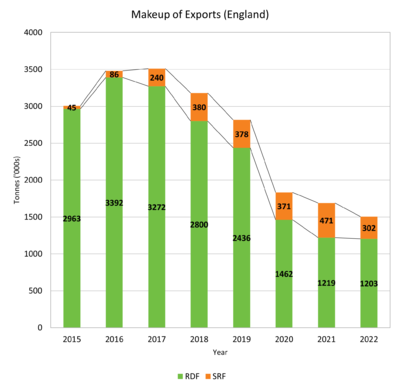Solid Recovered Fuel: Difference between revisions
Full stop |
m add page specific text |
||
| Line 1: | Line 1: | ||
[[Category:Tonnage & Waste Types]] | [[Category:Tonnage & Waste Types]] | ||
Solid Recovered Fuel (SRF) is distinct from [[RDF]] in that its quality as a fuel is far higher and is set in EU standards. It is typically used in processes that require a high quality, small particle size, high calorific value, low | Solid Recovered Fuel (SRF) is distinct from [[RDF]] in that its quality as a fuel is far higher and is set in EU standards. It is typically used in processes that require a high quality, small particle size, high [[calorific value]], low [[Moisture Content]] material – such as cement kilns and new-generation [[ATT]] plants. | ||
Whilst the data for SRF is often reported within the overall [[Waste Derived Fuel]]/[[RDF]] statistics, there is increasing evidence of a growth in SRF production and export and reduction in [[RDF]]. | |||
[[File:RDF and SRF Export.png|400px|left|RDF and SRF Export - after CIWM presidential report 2018]] <ref>CIWM Presidential Report 2018 – RDF Trading in a Modern World</ref>. | |||
==References== | |||
Revision as of 15:29, 3 March 2020
Solid Recovered Fuel (SRF) is distinct from RDF in that its quality as a fuel is far higher and is set in EU standards. It is typically used in processes that require a high quality, small particle size, high calorific value, low Moisture Content material – such as cement kilns and new-generation ATT plants.
Whilst the data for SRF is often reported within the overall Waste Derived Fuel/RDF statistics, there is increasing evidence of a growth in SRF production and export and reduction in RDF.

[1].
References
- ↑ CIWM Presidential Report 2018 – RDF Trading in a Modern World
